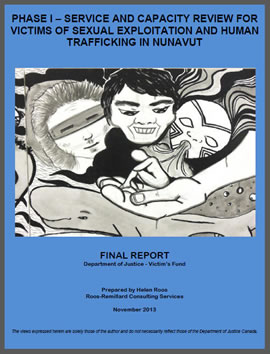Inuit girls and women are the victims of sexual exploitation and trafficking, both in Nunavut and in major cities, according to a revealing 146 page report prepared by a Canadian consulting firm.
 Helen Roos, President of Roos-Remillard Consulting Services, recently released her report, “Service and Capacity Review for Victims of Sexual Exploitation and Human Trafficking in Nunavut,” which she prepared for the Canadian Department of Justice. It has received wide coverage in the Canadian press over the past couple of weeks.
Helen Roos, President of Roos-Remillard Consulting Services, recently released her report, “Service and Capacity Review for Victims of Sexual Exploitation and Human Trafficking in Nunavut,” which she prepared for the Canadian Department of Justice. It has received wide coverage in the Canadian press over the past couple of weeks.
Ms. Roos indicates that the Inuit are especially vulnerable to these crimes because of the poverty, levels of abuse, and housing shortages in Inuit communities. Those conditions encourage some females to allow themselves to be lured into situations that can become quite difficult. In some cases, it appears from the stories as if the families of the girls are complicit in permitting their daughters to become involved in dangerous activities.
Not surprisingly, Internet social media represent one of the places where exploiters lure vulnerable women and children into trouble. Some of the publicity about the report has irritated defenders of the Inuit society. However, Ms. Roos hopes that the controversy will prompt more community awareness of the growing problems. The report itself, and an annex consisting of detailed case studies, are available on the website of the consulting firm.
Nunatsiaq Online provides an effective overview of the report. A child sells herself for money, with the permission of her mother. An adult woman forces an 11-year old to perform sexual favors for drugs, liquor, and cash. The report presents dozens of disturbing stories such as those.
The study was based on several sources: the RCMP, anecdotal stories, and information obtained from about 40 Inuit living in the Ottawa area. There, according to Ms. Roos, the Inuit “reported experiences of grooming, baiting, conning and exploitation to perform forced sex work, either at the hands of their common law partner, boyfriend, parent or pimp.”
Sex criminals often threaten their victims to not tell anyone about their experiences, according to Ms. Roos, so they usually do not want the police to find out. They are hesitant to even meet with social workers, since those people are then obligated to inform the police. For those reasons, “Inuit represent one of the most vulnerable populations in Canada” for sexual exploitation and human trafficking, the report argues.
Part of the problem is the history of family abuse, violence, overcrowding, and homelessness among the Inuit themselves. Especially in small communities, sexual predators, according to the report, can be “a parent, spouse, boyfriend/girlfriend, friend or employer who exploits a youth or adult, either for forced labour, forced sex or both.”
During the course of her research, the author discovered someone trying to sell an Inuk infant on Facebook. The RCMP reacted immediately, but would not provide further information back to the consulting firm. Ms. Roos discovered that a man had staked out a market in Iqaluit, the capital of Nunavut, and had offered money to the mother of one baby for her child.
The report makes numerous recommendations, such as increased training, development, and funding to better protect children and young people, more effective public awareness, and programs and services based right in the Inuit communities. “People need to start connecting the dots, they need to stop being so complacent, particularly where children are concerned,” Ms. Roos writes.
According to one news story, statistical reporting of human trafficking in Canada is inadequate. But some social workers see the report as most useful. Peter Dudding, Director, Children and Family Services for the government of Nunavut, cautiously praises the new study. “Helen’s [report] is the first work of its kind that I’m aware of … to really be asking these kinds of questions,” he says, though he indicates he is “not directly aware” of the trafficking she describes.
The director of an Inuit addiction and treatment facility in Ottawa, Ben Bridgstock, said that Inuit females are especially vulnerable to sex trafficking, especially when they move south to major Canadian cities. “If the report leads to a more formalized investigation, hard facts and figures, that would be brilliant,” he says.